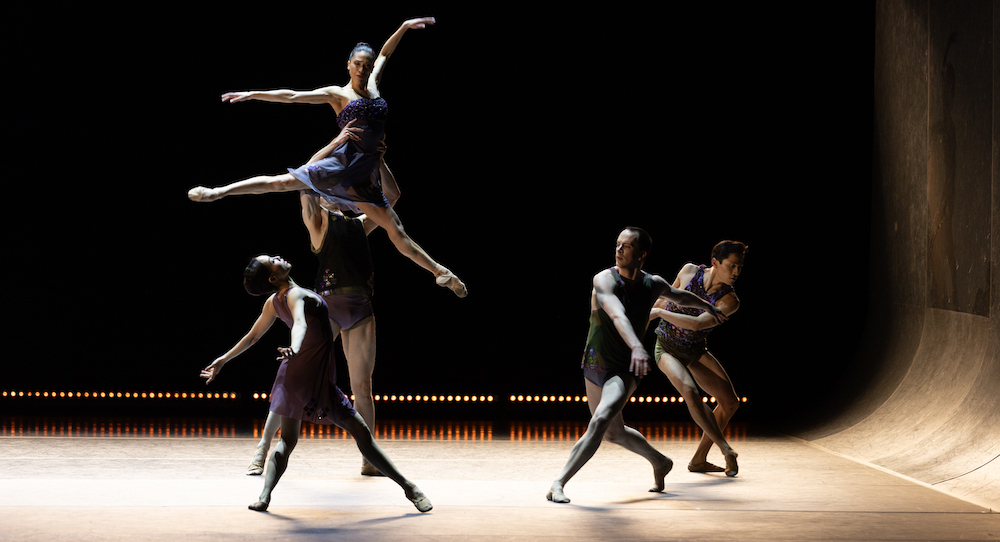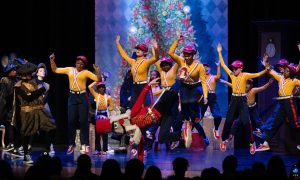May 12, 2024.
Citizens Bank Boston Opera House, Boston, MA.
“I’m here, I did it,” I thought as I settled into my seat for a run of Boston Ballet’s Spring Experience; I had made it to the whole 2024-2025 Season. Interestingly, unlike the other programs in the season, this one didn’t include classical work. All three works were rather contemporary and abstract in nature – enigmatic, even.
Some people say that such abstract art just isn’t their thing. They, like everyone, are entitled to their own tastes and experiences of art. For me, however, there can be beauty in deep abstraction. This program had me standing all the stronger in that view. Furthermore, the creative multiplicity and possibility in this program, as the last in the season, left room for further expansion and exploration next season – and beyond.
The Space Between, a world premiere from Ken Ossola, was up first. In program notes, Ossola described taking inspiration for the work from sculpture that “leaves an open door to the imagination in a poetic way for the viewer.” For me, this work did the same — challenging our mental “scripts” and pushing just to the edge of something complete, so that we could fill in the rest for ourselves. It pushed at that open door, inviting us in the audience to walk through.
The work also put the score center stage, both literally and figuratively – with an original composition (Toccata for Orchestra and Live Electronics) from Boston Ballet Music Director Mischa Santora as well as live electronic music from Michael Cain.
A long overture began the work – so long that I wondered why that long, as intriguing as the music was. It was only the beginning of playfully provoking our expectations. Considering the length of the piece, it was actually an appropriate length, I reflected after the curtain fell.
The score kept booming as the dancers filled the stage, from a small to a larger group. The movement seemed softer and slower in comparison. As the piece progressed, the score eased and the two matched more closely. I smiled to myself to think that this was another defiance of our expectations – a new sort of structure and aesthetic arc. For me, that daring was working.
Perhaps I was, at least in part, only enamored with the smooth movement pathways and exquisite musicality of these artists. Ossola’s vocabulary had them spinning limbs like propeller blades, eating up space along with the score’s sweeps and slides. Fresh choices with partnering took dancers through various levels in space, and through myriad relationships to each other’s gravity. They danced in between Benjamin Phillips’ minimalist set pieces — white walls along the stage’s wings, taking on the cool colors of Brandon Stirling Baker’s lighting.
Later on in the work, a good sized ensemble danced somewhat soft, subtle movement – a challenge to yet another expectation we might have: that large ensembles dance something big, vivacious, grand. The suave at hand – the “just enough”, not needing to push or prove a thing – added to the soothing feeling I got from the blues and symmetrical shapes filling the stage.
Yes, soothing indeed – but there was also a compelling tension at hand, from the stopping at the edge of something more monumental. We in the audience could peer over that edge in bubbling anticipation. That was “the space between” – full of uncertainty, but also potential.
We also might have also expected a standard climax and resolution, a crescendo and decrescendo of action and intensity – but we didn’t get one. The dancers came together and made a tableau. Fin. I needed to sit with what I just experienced for a moment to fully appreciate it, but appreciate it I did.
William Forsythe’s Blake Works III: The Barre Project (2022) came after the first intermission. This work felt just as singular, just as daring, as when I first saw it. Yet, I could even more so appreciate the calm amidst the storm in Forsythe’s movement – the moments of softened speed and kinetic intensity.
Perhaps those heightened moments are just so virtuosic, so spectacular, that one’s attention stays there at first. With subsequent viewings, one can appreciate and enjoy deeper layers and corners. That’s characteristic of rich, dynamic art like this – and something to be appreciated and honored.
Closing the program was Jiří Kylián’s bold, enticingly abstruse Bella Figura (1995). The operatic score (from various classical composers), as well as the way certain dancers related in space, brought to mind something spiritual – even religious. Long red curtains (set design by Kylián), hanging in shifting configurations throughout the work, instilled a sense of boundaries: the unknown, the inaccessible, the forbidden.
Frequent use of reds added to that a sense of passion: whether in combat, romance, or plain old anger. That was before there was literal fire downstage left. Awe, mystery, a nagging sense of danger…it was all there on that stage. Short of any of that, Kylián’s keen sense of momentum moving through space – and how one can employ the capacities of the body in that path – were certainly enough to keep me engaged.
The program thus far (not to mention what I had already known of the company) had demonstrated these dancers’ stellar musicality. They brought that to this work as well, finding and channeling each musical nuance. Spines and hips were sumptuous and sultry. The momentum kept flowing. Yet accents also were on offer, bringing something flamenco to bear.
The ending solidified the curious abstraction at hand; dancers left the stage one-by-one, leaving one dancer to move alone. Why had they left, and why had that persona stayed? More questions were where that came from. But the pleasure can be in the question rather than the answer – perhaps a cliché, but not without truth to it. Finding our own answers can be where the real discovery is.
Whether abstract or more straightforward narrative, I look forward to what Boston Ballet will bring us next season and beyond. The door – to more enticing questions, to further exploration – is open. I’m not sure about you, but I sit in gleeful anticipation of what I’ll find on the other side.
By Kathryn Boland of Dance Informa.















